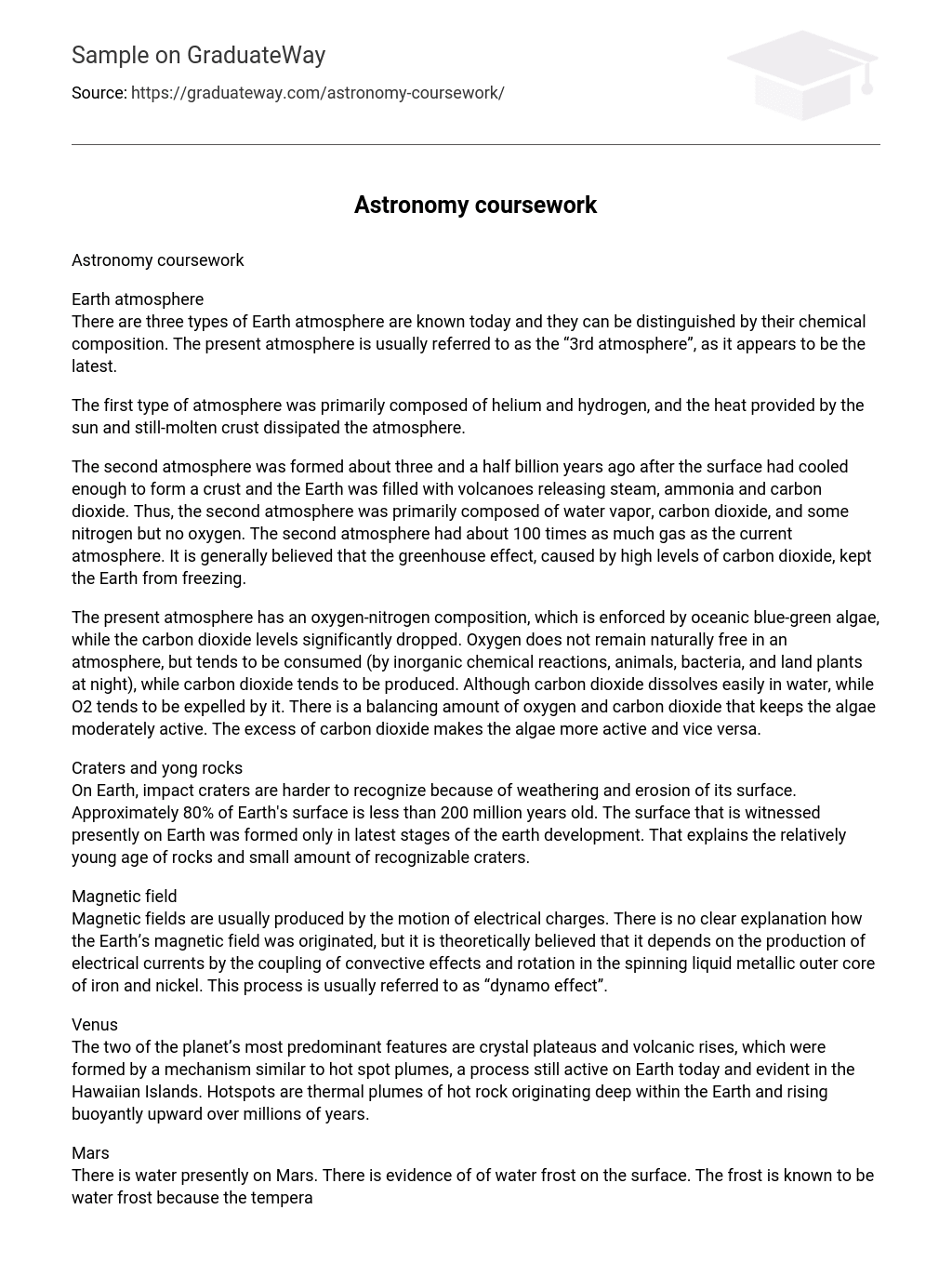Earth atmosphere
There are three types of Earth atmosphere are known today and they can be distinguished by their chemical composition. The present atmosphere is usually referred to as the “3rd atmosphere”, as it appears to be the latest.
The first type of atmosphere was primarily composed of helium and hydrogen, and the heat provided by the sun and still-molten crust dissipated the atmosphere.
The second atmosphere was formed about three and a half billion years ago after the surface had cooled enough to form a crust and the Earth was filled with volcanoes releasing steam, ammonia and carbon dioxide. Thus, the second atmosphere was primarily composed of water vapor, carbon dioxide, and some nitrogen but no oxygen. The second atmosphere had about 100 times as much gas as the current atmosphere. It is generally believed that the greenhouse effect, caused by high levels of carbon dioxide, kept the Earth from freezing.
The present atmosphere has an oxygen-nitrogen composition, which is enforced by oceanic blue-green algae, while the carbon dioxide levels significantly dropped. Oxygen does not remain naturally free in an atmosphere, but tends to be consumed (by inorganic chemical reactions, animals, bacteria, and land plants at night), while carbon dioxide tends to be produced. Although carbon dioxide dissolves easily in water, while O2 tends to be expelled by it. There is a balancing amount of oxygen and carbon dioxide that keeps the algae moderately active. The excess of carbon dioxide makes the algae more active and vice versa.
Craters and yong rocks
On Earth, impact craters are harder to recognize because of weathering and erosion of its surface. Approximately 80% of Earth’s surface is less than 200 million years old. The surface that is witnessed presently on Earth was formed only in latest stages of the earth development. That explains the relatively young age of rocks and small amount of recognizable craters.
Magnetic field
Magnetic fields are usually produced by the motion of electrical charges. There is no clear explanation how the Earth’s magnetic field was originated, but it is theoretically believed that it depends on the production of electrical currents by the coupling of convective effects and rotation in the spinning liquid metallic outer core of iron and nickel. This process is usually referred to as “dynamo effect”.
Venus
The two of the planet’s most predominant features are crystal plateaus and volcanic rises, which were formed by a mechanism similar to hot spot plumes, a process still active on Earth today and evident in the Hawaiian Islands. Hotspots are thermal plumes of hot rock originating deep within the Earth and rising buoyantly upward over millions of years.
Mars
There is water presently on Mars. There is evidence of of water frost on the surface. The frost is known to be water frost because the temperature was too high for carbon dioxide frost. However, there is no liquid water on Mars. Water is only present on Mars in the form of ice or water vapor.
The main reason for the absence of liquid water on Mars today is the low pressure. The average surface pressure on Mars is 100 times less than sea level pressure on Earth. There is evidence that in the mountains on Earth at lower pressures water boils at lower temperatures. If the pressure is lowered sufficiently the boiling point will become as low as the freezing point. This is known as the triple-point pressure. For pressures below the triple-point a liquid cannot exist. The pressure on Earth is below the triple-point of carbon dioxide and therefore this material does not form a liquid but instead sublimes from ice to vapor. On Mars the average pressure is equal to the triplepoint of water. Thus for most of Mars, water behaves like carbon dioxide does on Earth – it sublimes from ice to vapor. Those places where the pressure is above the triple-point are either too dry or too cold for liquid water. Thus on Mars today, there is no liquid water at any place or any time.
However, there is considerable evidence that Mars had liquid water on its surface in the past. The most impressive evidence for water on Mars comes from the outflow channels. These are large flood features carved by the rapid flow of enormous quantities of some fluid. The most likely fluid is water. Similar features are seen on Earth indicating massive floods in the past. On Mars it is thought that water was trapped underground beneath a frozen layer of surface ice. Trapped by the ice the pressure in the water would build up. Eventually, a break in the ice would release water and initiate a massive flood. The huge amounts of water required to explain these flood features indicates that Mars must have had a lot of water. Calculations based on extrapolating the flood features to the whole planet imply that Mars had enough water to form a global layer over 500 meters thick. Enough water to make an ocean on Mars if it was ever present altogether on the surface.
Bibliography
“Ancient Mars water: a deep source?” Science News, Feb 24, 2001.
Cowen, R. “Shades of Venus” Science News, April 17, 2004.
Monastersky, R. “Earth’s heart beats with a magnetic rhythm – rhythm of strength of magnetic field.” Science News, Nov 20, 2001.
Svitil, Kathy A. “Red Waterworld – water on Mars.” Discover, Sept, 2002.





